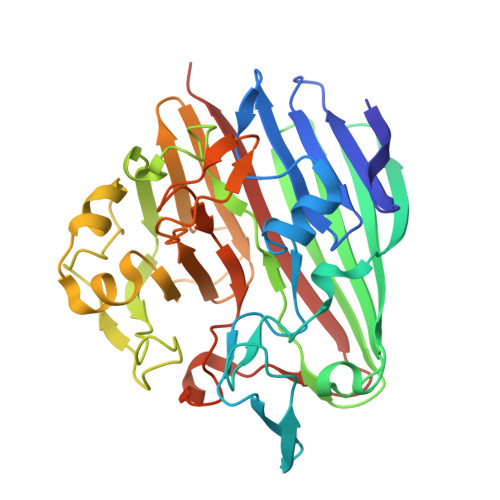The Catalytic Mechanism of Galactose Mutarotase
Thoden, J.B., Kim, J., Raushel, F.M., Holden, H.M.(2003) Protein Sci 12: 1051-1059
- PubMed: 12717027
- DOI: https://doi.org/10.1110/ps.0243203
- Primary Citation of Related Structures:
1NS0, 1NS2, 1NS4, 1NS7, 1NS8, 1NSM, 1NSR, 1NSS, 1NSU, 1NSV, 1NSX, 1NSZ - PubMed Abstract:
Galactose mutarotase catalyzes the first step in normal galactose metabolism by catalyzing the conversion of beta-D-galactose to alpha-D-galactose. The structure of the enzyme from Lactococcus lactis was recently solved in this laboratory and shown to be topologically similar to domain 5 of beta-galactosidase. From this initial X-ray analysis, four amino acid residues were demonstrated to be intimately involved in sugar binding to the protein: His 96, His 170, Asp 243, and Glu 304. Here we present a combined X-ray crystallographic and kinetic analysis designed to examine the role of these residues in the reaction mechanism of the enzyme. For this investigation, the following site-directed mutant proteins were prepared: H96N, H170N, D243N, D243A, E304Q, and E304A. All of the structures of these proteins, complexed with either glucose or galactose, were solved to a nominal resolution of 1.95 A or better, and their kinetic parameters were measured against D-galactose, D-glucose, L-arabinose, or D-xylose. From these studies, it can be concluded that Glu 304 and His 170 are critical for catalysis and that His 96 and Asp 243 are important for proper substrate positioning within the active site. Specifically, Glu 304 serves as the active site base to initiate the reaction by removing the proton from the C-1 hydroxyl group of the sugar substrate and His 170 functions as the active site acid to protonate the C-5 ring oxygen.
Organizational Affiliation:
Department of Biochemistry, University of Wisconsin, Madison, Wisconsin 53706-1544, USA. [email protected]
















